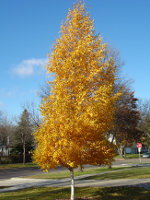Mon-Fri 9am - 5pm Mountain time
Common Hackberry vs Dakota Pinnacle Birch
Celtis occidentalis
Betula platyphylla fargo
CUSTOM GROW
The Common Hackberry is a medium-sized deciduous tree that resembles the American Elm but is immune to Dutch Elm Disease. They are versatile and can adapt to a variety of growing conditions.
It produces purple-red, berry-like fruit with a large seed in the center. Both the sweet flesh, which tastes similar to dates, and the crunchy seed are edible. The fruit remains on the tree throughout the winter, offering a valuable food source for birds and other wildlife.
The Common Hackberry can also be a great addition to a pollinator garden. The tree itself is a host for the larvae of several butterfly species and the flowers provide a source of pollen and nectar.
Dakota Pinnacle Birch is a hardy deciduous tree with a columnar to narrowly pyramidal form. It makes a beautiful accent tree, and Dakota Pinnacle Birch is insect resistant and drought tolerant.
Dakota Pinnacle Birch features smooth white bark and dark, green foliage that turns yellow in the fall.
Common Hackberry Quick Facts
Dakota Pinnacle Birch Quick Facts
In row spacing: 1.8 - 2.4 m (6 - 8 ft)

